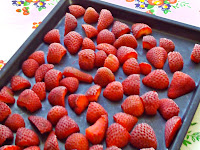Recently I met author Melissa Tossetti, heard about her book, "Living the
Savvy Life: the savvy woman's guide to smart spending and rich living" (with co-author Kevin Gibbons), and picked up a copy. I was intrigued mainly because her approach to finance sounded so much like my approach to food - it's about living well, in alignment with your own values, not about following a formula (to save x$, to lose x pounds). And most importantly, the key messages about living intentionally seemed inherently green, again paralleling my key messages about eating and making food choices. Which brought me to the question of whether savvy living is the equivalent of green living, and vice-versa.
Some chapters strictly cover personal finance, with sound coverage of the basics needed for money management. No green spin in this portion (picking investments with tools like the Dow Jones Sustainability Index, for instance). But that seems appropriate for the scope of the tutorials.
The chapters that focus on key areas where most women (and arguably, men) spend most of their income each do have an underlying green thread, however. For instance, Chapter 6: Home, advocates for de-cluttering the home, employing second-hand treasure for decorating, sharing tools and other items instead of owning one of everything yourself, and enjoying simple pleasures at home.
Similarly, Chapter 8: Wardrobe, provides explicit steps for breaking the cycle of overstuffing closets with clothing that doesn't really look and feel great. The tips include a host of alternatives to trendy stores and malls, including but not limited to second-hand stores. While there is no 'shop green' message about finding fair-trade, sweat-free, organic fabric clothing, the basic messages of not wasting resources (time, money, storage, cleaning, etc) on things that don't really suit who you are is green in a more old-fashioned way.
The least-green feeling chapter for me was Beauty, but only because my usual first questions (What's in this product? Was it tested on animals? Is it safe? How's it rank on the
SkinDeep database?) weren't addressed. On the other hand, the authors remind us of some fundamental issues that can prevent time and money wasted on buying inappropriate products - understand what your body needs, clean up your diet, and protect your skin from the sun, among them.
In contrast, I felt immediately at home in Chapter 7: Entertainment. Reminders about holding seasonal celebrations, exploring the sights of your own local area, recycling books and DVDs, and enjoying simple pleasures all resonated with me. And, like the Shopping chapter, it edged pretty close to a key principle of voluntary simplicity: figure out what really makes you happy, and let the rest go.
The big work (your mission, if you choose to accept it) recommended by this book is not to track spending, sock away a nest egg, or in any way meet someone else's standards of material success. Rather, it provides tools to help the reader asks insightful questions about what makes her happy and to consider where her personal resources are best spent. And while there's no guarantee that a reader's personal choices will be green ones, the authors make a convincing case for a resource-conservative approach (less clutter, more simple pleasures; less buying stuff, more sharing; and take care of what you value) enhancing both material security and emotional satisfaction in everyday life.
Diving Deeper on the Food Issues
The longest, most detailed chapter is Food. Like the other chapters on lifestyle, green is not the element at the top of the agenda. But it sneaks in as much or more so as it does in the other sections. For the next few months, I will be taking the recommendations one by one, implementing them at home, and sharing what I learn from the exercise.


























